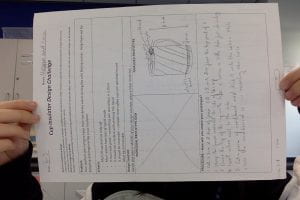The challenge we were trying to solve was to make an insulator so hot drinks don’t cool down as quickly in cold weather.
First, we read the challenge repeatedly so we understood completely and brainstormed ideas by ourselves so we could accomplish the first step of the design process. We got to look at the different materials provided and discussed which one kept the most heat. After that we drew models and labeled it with the different materials we planned to use. We thought that foam worked best because it was warm and didn’t let air through, which is part of the second step in the design process which is planning the different things required to make the desired product.
Next, we drew a final model and started making a first prototype with paper, following the third step of creating. We measured the length of the cup, cut out paper and labeled the paper with the materials we planned to use. We planned to cover the surface of the cup entirely with foam and include Velcro one side so it’s easy to take off. We also decided to cover the top of the cup with tin foil that’s stuck onto plastic to maximize the effect of keeping it warm. We decided that the tin foil should act like a flap for the top of the mug and easily taken on and off for quick drinking.
Finally, we made our final prototype with the planned materials. We also discovered that the foam melts in hot temperatures which meant that we had to minimize the amount of hot glue we used and stick to tape instead. This made the design a lot harder because if there was too much of it the insulator would melt, and the foam will become thin. In the end, we managed to find a better solution of tape.
In the end, I reached a conclusion of that when you cover the cup with foam, the liquid inside will remain hot. This is because the Styrofoam’s materials made it hard for hot gases to escape and also generated heat. The Styrofoam helped and we can see that because the mug without the insulator lost 20.9degrees by 10 minutes but when we covered the cup with foam it only lost 12degrees in 10 minutes for the first try and lost only 10.4degrees in the second try. This shows that covering the cup with Styrofoam, it helps the temperature stay warm by 10.5degrees.
This happened because in the cup, the water gets hot enough to turn to gas. If there isn’t anything to block it, the hot gas will escape and decrease the temperature of the cup because the gas is giving off energy. If we cover the cup with tin foil and Styrofoam, the gas cannot escape and all the energy will go and heat the cup.
Our design worked, but not very well. There were many flaws, such as the Styrofoam melting due to the temperature of the liquid in the cup. This might be one of the reasons the temperature started decreasing rapidly by the end of 6 minutes. Another flaw that might have made the rapid decreasing occur was that the Velcro was not stuck on very well and started falling apart. However, the Styrofoam did help keep the heat in moderate temperature for about 5 minutes at the start of the experiment.
The hardest thing about this project was making sure the insulator was not bulky because if it was too hard to carry then it wouldn’t meet the criteria. One thing I would do different next time is to plan it more elaborately before getting into action and making the prototype.
Overall, I thought our design was okay because it met the criteria and managed to preserve heat.

 .
. 